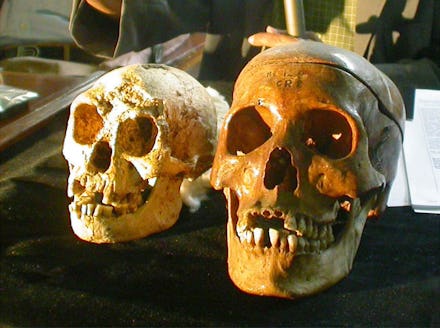A Mysterious, Ancient "Hobbit" Skeleton Is Confusing the Hell Out of Modern Scientists

More than a decade ago, anthropologists discovered a bizarre skeleton on the island of Flores in Indonesia.
The skeleton was fully grown, but only stood about 3.5 feet tall, earning it the nickname "the hobbit." (For what it's worth, Tolkien Gateway says the average height of the fictional hobbits in J.R.R. Tolkien's Lord of the Rings series is 2 to 4 feet, so it seems like an apt nickname.) Scientists estimate it disappeared only around 15,000 to 18,000 years ago, which means it walked the Earth at the same time as modern humans.
But ever since its discovery, anthropologists have argued over its classification. Last year, the hobbit made headlines when a group of anthropologists published research that asserted the hobbit was a completely new species, separate from modern Homo sapiens.
Classification of human-like skeletons is often based on analysis of the teeth, jaw bone and the shape and size of the skull, and the hobbit's features didn't fit into any other group in the Homo genus. Especially its skull — it's much smaller than the skulls of modern humans.
But there was a huge backlash against the idea that the hobbit represented a separate species. Some argue that the hobbit's strange looking skull can be explained by normal variations in hominid skulls. Others argue the hobbit might simply be a dwarf human. Or it may have been born with some kind of genetic defect or other condition that makes it appear so starkly different from us.
Anthropologists couldn't agree, so the mystery remained unresolved. Now anthropologists Antoine Balzeau and Philippe Charlier have gotten their hands on the hobbit, and they've performed scans of the skull that they say are 25 times more detailed than previous scans, reported BBC Earth. Based on these detailed scans, Balzeau and Charlier say there's no way the hobbit is a modern human.
"The shape of its skull is definitely not the shape of a modern human skull. ... Even a human with pathologies," Balzeau told BBC Earth.
The research has been accepted for publication in the Journal of Human Evolution.
It's unlikely this study will be the final word. We can't know for sure that the hobbit is a different species, because researchers have found only one intact skull on Flores. We also can't know for sure that it's related to modern humans, because if it's simply a genetic defect, we haven't found any other human with the same appearance.
Anthropologists will have to keep digging if we ever hope to fully understand our ancestral lineage.